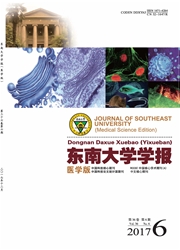

 中文摘要:
中文摘要:
目的:研究羧甲基壳聚糖(CMCS)载药纳米微球的制备及其对肿瘤细胞的杀伤和靶向作用。方法:将壳聚糖分子上的羟基改性成羧基,用于化学偶联阿霉素(ADR),并进一步在载药纳米微球上修饰转铁蛋白(Tf),制备主动靶向载药纳米微球;采用MTT(四甲基氮唑蓝)法评价载药纳米微球对喉肿瘤细胞的杀伤率;应用原子力显微镜(AFM)对载药纳米微球作用后喉肿瘤细胞表面超微结构的变化进行形态学观察。结果:载药纳米微球对喉肿瘤细胞的杀伤率比同剂量的ADR提高了31%,表面进一步修饰Tf后其杀伤率比同剂量ADR提高了41%。ADR与载药纳米微球对喉肿瘤细胞的细胞膜表面超微结构的影响存在较大的差异。结论:载药纳米微球在肿瘤细胞表面受吸附或受体介导的内吞作用,致使微球在细胞表面的释药机制不同于单独药物的扩散模型,从而明显提高对肿瘤细胞的杀伤率,这对探讨药物的作用机制和靶向药物的研发具有重要的指导意义。
 英文摘要:
英文摘要:
Objective:Preparation of targeting carboxymethyl chitosan(CMCS) drug-loaded nanoparticles and study of its killing and targeting effects on cancer cells.Methods: Targeting drug-loaded nanoparticles were prepared by changing the hydroxide on chitosan to carboxyl to form CMCS,and then conjugated with adriamycine(ADR) and transferrrin(Tf).MTT assay was used to envaluate the killing effect of CMCS drug-loaded nanoparticles on human laryngo Hep-2 cancer,and the morphology of membrane surface ultrastructures of cancer cells were observed by atomic force microscopy(AFM).Results: The results revealed that CMCS drug-loaded nanoparticles were more potent in killing cancer cells.AFM images showed that there were distinct differences of membrane surface ultrastructures after ADR and CMCS drug-loaded nanoparticle treatment.Conclusion: CMCS drug-loaded nanoparticles are more potent in killing cancer cells than ADR attributing to the adsorption effect or the receptor-mediated endocytosis of CMCS drug-loaded nanoparticles on cancer cells.These results will contribute to better understanding of the anticancer mechanism of targeted drugs.
 同期刊论文项目
同期刊论文项目
 同项目期刊论文
同项目期刊论文
 A novel gold nanorod-based spectrographic method for evaluating the curcumin inhibitory action on He
A novel gold nanorod-based spectrographic method for evaluating the curcumin inhibitory action on He Construction of An Electrochemical Cytosensor Based on Polyaniline Nanofiber/Gold Nanoparticle Inter
Construction of An Electrochemical Cytosensor Based on Polyaniline Nanofiber/Gold Nanoparticle Inter Constructions of polyaniline nanofiber-based electrochemical sensor for specific detection of nitrit
Constructions of polyaniline nanofiber-based electrochemical sensor for specific detection of nitrit Naked eye detection of glutathione in living cells using rhodamine B-functionalized gold nanoparticl
Naked eye detection of glutathione in living cells using rhodamine B-functionalized gold nanoparticl Synthesis, Characterization and Antioxidant Activity of a Novel Organogermanium Sesquioxide with Res
Synthesis, Characterization and Antioxidant Activity of a Novel Organogermanium Sesquioxide with Res Facile solution routes for the syntheses of water-dispersable germanium nanoparticles and their biol
Facile solution routes for the syntheses of water-dispersable germanium nanoparticles and their biol Multifunctional optical probe based on gold nanorods for detection and identification of cancer cell
Multifunctional optical probe based on gold nanorods for detection and identification of cancer cell A novel gold nanoparticle-doped polyaniline nanofibers-based cytosensor confers simple and efficient
A novel gold nanoparticle-doped polyaniline nanofibers-based cytosensor confers simple and efficient Label-free oligonucleotide detection method based on a new L-cysteine-dihydroartemisinin complex ele
Label-free oligonucleotide detection method based on a new L-cysteine-dihydroartemisinin complex ele Connection between biomechanics and cytoskeleton structure of lymphocyte and Jurkat cells: An AFM st
Connection between biomechanics and cytoskeleton structure of lymphocyte and Jurkat cells: An AFM st Electrochemical activity of holotransferrin and its electrocatalysis-mediated process of artemisinin
Electrochemical activity of holotransferrin and its electrocatalysis-mediated process of artemisinin 期刊信息
期刊信息
